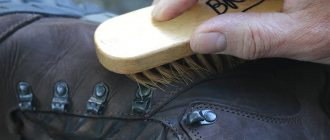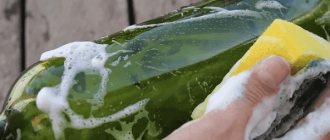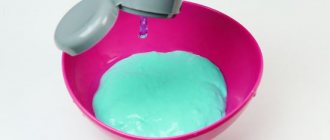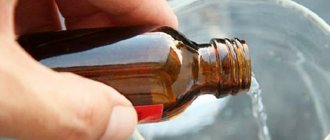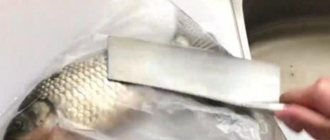Who hasn't encountered the problem of a splinter? This situation often arises in everyday life and sometimes causes many problems. Especially if the splinter is driven by small children who cannot tolerate even minor pain. We will tell you how to deal with this problem quickly and without consequences.
Author of the article / Site experts Shulepin Ivan Vladimirovich, traumatologist-orthopedist, highest qualification category
Total work experience over 25 years. In 1994 he graduated from the Moscow Institute of Medical and Social Rehabilitation, in 1997 he completed a residency in the specialty “Traumatology and Orthopedics” at the Central Research Institute of Traumatology and Orthopedics named after. N.N. Prifova.
Splinter danger
Nature has provided a mechanism for independently combating splinters. After all, sharp foreign bodies cut into our skin quite often - in nature, when working in the garden, or when handling sharp objects carelessly. Cells of the immune system, primarily tissue phagocytes, rush towards the foreign agent, and the process of “absorption” of the uninvited guests begins. Some of the cells die, forming the basis of pus. If the splinter is small and located in the superficial areas of the skin, it is pushed to the surface along with pus. But in the case of deep penetration into the tissue, the process of suppuration becomes widespread. If you do not pull out the splinter in this case, the affected area begins to tear, and the following symptoms appear:
- Pain, sometimes severe, throbbing.
- Redness and swelling of the sore spot.
- Increased body temperature.
- Spread of inflammation to neighboring areas.
This situation leads to the development of complications, including sepsis. Therefore, the general approach is to immediately remove any splinters when they are discovered.
This is usually available at home. Difficulties arise when a child has a splinter when he cannot accurately name the location of the injury. In such cases, you need to contact a pediatrician or traumatologist.
Don't leave a splinter unattended! It may be dangerous!
How to protect yourself from harm?
The reality around us is full of certain surprises, from which it is often impossible to protect ourselves. But following certain rules will reduce the possibility of damage to the skin surface followed by the procedure for removing the splinter.
. These include the following parameters:
- maintaining order in the space around us;
- restriction of use by objects with damaged surfaces;
- careful handling of products made of untreated wood or metal;
- prompt and attentive cleaning of broken glass, etc.
Compliance with basic safety requirements and due care when carrying out any actions will protect yourself from skin damage.
Useful information on the topic:
- Diagnosis of surgical diseases
- Treatment of surgical diseases
- How is a consultation with a surgeon carried out?
- Examination by a surgeon
- Surgery - the science of internal medicine
- How is a surgeon's appointment carried out?
- Pediatric surgeon
- Removal of skin tumors
- Paid surgeon
Methods for removing a shallow splinter
Fortunately, the vast majority of splinters are superficial and can be easily removed with improvised means.
With a needle
To remove an embedded splinter correctly, you need to follow the following sequence of actions (if the splinter is located on the palm or finger, not deep under the skin):
- First of all, you need to wash your hands, tweezers and needle.
- Next, treat the damaged area and tweezers (needle) with alcohol. Instead of a sewing needle, it is better to use a sterile one from a disposable syringe.
- It is necessary to ensure good visibility: open the curtains, turn on a bright lamp, wear glasses or use a magnifying glass.
- If the splinter is covered by a layer of epidermis, it must be removed by carefully prying it with a needle so that the tip of the splinter appears above the surface.
- If the tip can be grabbed with tweezers, it is carefully pulled out. The main danger at this stage is to break off and leave part of the splinter in the tissues. If this is not noticed, which is often the case, suppuration will continue. To prevent such a situation, the splinter is removed slowly and at the same angle at which it entered the tissue.
- Once you are sure that the splinter is completely out, apply pressure to the tissue around the wound. This will release contaminated fluid (blood, lymph, pus).
- The wound should be treated with an antiseptic (hydrogen peroxide, alcohol, iodine, brilliant green). If the injury is extensive, you can apply a bandage or cover the area with a bactericidal adhesive plaster.
You should consult a doctor in the following situations: if it is impossible to open the tip of the splinter (located very deep), part of it remains in the tissue and after the procedure pain, swelling and redness of the tissue persists (there is a high probability of the inflammatory process continuing).
Soda
There are several ways to remove a splinter without a needle. They are especially important for young patients and their parents, since the very sight of a needle causes a child to go hysterical. One of them is baking soda. To do this, you need to prepare a paste-like mass by adding a little water to a quarter teaspoon of soda. The mixture is applied to the affected area and sealed with an adhesive plaster for 24 hours. After this, the tip of the splinter should appear above the skin and it can be removed with tweezers. It is allowed to re-apply soda for another 24 hours. If the splinter still cannot be grabbed and pulled out, you should consult a doctor or, in the absence of severe inflammation, try another method.
Can
The technology of placing medical cups is becoming a thing of the past today. But it is perfect for “raising” the tip of a splinter above the surface of the skin. To do this, a burning cotton wick is placed inside the jar for one second, then it is removed, and the jar is quickly applied to the affected area. A kind of vacuum forms under it, which causes the splinter to move outward. The main thing is not to overheat the edges of the jar and cause a burn. This way you can painlessly remove the splinter from the smooth surfaces of the body.
Wax or glue
Very good for superficial splinters in a child who won’t let anyone approach him with a needle. It is enough to generously lubricate the surface with PVA glue or wax. After hardening, they can be easily removed without pain. The splinter sticks and comes out of the skin.
What is required for extraction?
It doesn't matter how deep the splinter is stuck in the tissue. It requires caution and asepsis.
To extract you will need:
- Provide yourself with good lighting.
- Tweezers or a regular sewing needle.
- Alcohol (vodka) for antiseptic treatment of devices.
- Several cotton pads. Pieces of clean fabric and a scarf are also suitable.
- Hydrogen peroxide to treat damaged skin.
- Zelenka or iodine.
Removing deep and invisible splinters
The greatest problems are caused by sharp objects that have penetrated deeply or, due to their properties, are not visible. These are thin shards of glass (for example, from a broken light bulb), a needle from a cactus, or a metal splinter made from tiny shavings. In such cases, it is almost impossible to see the exact location of the injury. We offer two proven ways to solve this problem.
Compress
“Ichthyol ointment” is suitable as a medicine. It has anti-inflammatory and antiseptic properties, so it not only helps the splinter come to the surface, but also prevents a situation where injured tissue festers and inflammation spreads to neighboring areas. The compress is applied at night or for a day (if necessary). The fatty ointment penetrates the epidermis, lubricates the foreign body and causes its tip to appear above the surface of the skin. After this, the splinter can be easily removed with tweezers. Other types of compresses:
- Potato gruel - grate fresh potatoes and leave for 8-10 hours.
- Aloe juice - moisten gauze with fresh juice from the leaves of the plant. It is an effective antibacterial and anti-inflammatory agent.
- Birch tar. The product has a strong odor. Polyethylene is placed on top of it and then bandaged overnight.
You can’t get too carried away with compresses.
If after the first time the splinter does not come out, you need to go to the emergency room. Otherwise, the thermal effect from the compress will provoke an inflammatory reaction.
Removing a glass shard
Glass usually gets to us in the most inconvenient and painful places: fingers and soles. We have already described the principles for extracting such fragments from the hand. The difficulty lies in the fact that glass easily breaks in fabrics, leaving fragments and completely invisible to the naked eye. Features of removing glass from a leg are as follows:
- Do not allow even the slightest pressure on the affected area. If a fragment is lodged in the heel, it is forbidden to step on that foot, as the glass will go deeper, crumble and can get into the blood vessels.
- Before removal, the injured area is first carefully washed with soap and then wiped dry, blotting with an absorbent towel. On a dry surface, a shiny shard will be more visible than on a wet surface.
- Before removal, you need to assess the depth of glass penetration into the tissue. If you are not sure that the splinter is superficial, it is better to consult a doctor, since there is a high probability that the glass will break when pulled out and some of it will remain in the tissues.
- It is better to remove the glass under a magnifying glass in good lighting.
- First, you need to move the fragment from its place with a needle, then grab it with tweezers and pull at the angle at which it entered the skin.
- If the splinter cannot be pulled out, the process cannot be forced due to the risk of breaking the fragile fragment and further injuring the tissue.
A more painless, but longer-lasting method is a compress with Ichthyol ointment. If the glass is stuck in your foot, this method is not suitable, because to do this you will have to stop walking for a day. But with a different localization, the compress will cause the splinter to come out on its own.
Glue and adhesive tape - is it worth it?
If a splinter gets into the child’s hand and he does not allow the use of tweezers or a needle, you can try to use medical glue.
It is sold in a pharmacy and is called BF-6 glue or BF-2 glue. The wound is smeared with glue, and when it turns into a dense elastic film, it is carefully removed, usually along with the splinter. Using other glue to remove a splinter is strictly prohibited! On the Internet there are tips on using PVA glue, silicate glue and even Moment glue for these purposes. This is absolutely impossible to do, otherwise the risk of serious inflammation will increase by an order of magnitude, and the consequences will be very unpleasant. Medical glue is effective only on delicate children's skin; for an adult this method is not strong enough.
It often happens that several small splinters get into the hand at once, for example, from a cactus, rose hips, or glass wool. For removal, you can use an adhesive plaster without a bactericidal pad or regular tape. It is enough to stick the adhesive material on the affected area, and then smoothly pull it up.
As a rule, in this way it is possible to get rid of interfering thorns. But if the splinter is large, for example, a piece of wood chips, you won’t be able to get it out this way.
Removing a splinter from an eye
Each person removed a speck from his eye. If it is located superficially, rinsing with warm water is sufficient. To do this, you need to lean over the water, wet your eyes generously with the palms of both hands and blink. You can pull down the upper or lower eyelid and pick up the splinter with a damp cotton pad. After the procedure, rinse the eyes again and apply antiseptic eye drops (Albucid, Tobrex and others). You can only remove splinters from your eyelids yourself. If a foreign body is located in the eyeball, you should urgently consult a doctor. Rules for first aid for eye splinters:
- Do not rub the injured eye with your hand.
- Apply glycerin or spread with sterilized sunflower oil or Vaseline.
- Apply a soft bandage to the eye.
- If you are sure that metal shavings have gotten into your eye, you can try removing them with a magnet. If unsuccessful, also consult a doctor.
When performing independent manipulations in the eye, you need to do them only with clean hands and in the direction from the temples to the bridge of the nose.
What products should you give up?
Now let's talk about what you shouldn't use. Folk remedies such as grated potatoes and cabbage leaves will be practically useless for removing splinters. The only thing they can do is relieve swelling - excessive accumulation of fluid around the damaged area of the skin. That is why it sometimes seems that there is benefit in their use.
But cabbage and potatoes are not able to either remove inflammation or soften the skin enough for the foreign body to come to the surface.
It is better not to use such means, although there will be no great harm from their use.
Harm will come from using such strange recipes as fresh lard, baked onions, and even chewed brown bread crumbs. Yes, yes, and such, if I may say so, recipes can be found on the Internet.
The use of such products is a direct way to introduce an infection into the wound and cause purulent inflammation, and sometimes sepsis! There's no need to take that risk. If you couldn’t deal with the splinter at home, the direct route is to the emergency room for help from qualified doctors!
Removing a splinter from a child
The problem of splinters in young children is much greater than in adults. Solving it is complicated by the fact that children cannot show the exact location of the injury, do not tolerate pain well and cannot stand the sight of a needle, which parents traditionally take to remove a foreign body. Therefore, if you suspect that your baby has received a splinter, you need to remember the following recommendations:
- The first thing you need to do is calm the little patient down and distract him with toys. Otherwise, the child will not allow you to touch the sore spot and may drive the splinter even deeper.
- Methods without a needle are better for children. This is extraction with glue, adhesive tape, or “Ichthyol ointment.”
- The child can be offered a “water game” by adding baby soap to a bowl of warm water. The skin of the injured area will soften, and the tip of the splinter will appear above the surface.
The most important thing in helping a child is the peace of mind of the parents.
If you are not confident in your abilities or the splinter has entered deeply into the tissue, it is better to go to the emergency room, where your baby will quickly receive professional help.
Where to go for help?
The range of services provided by private medical institutions makes it possible, preventing unnecessary waste of time and effort, to receive competent assistance in any specialized area.
The variety of clinics makes it somewhat difficult to choose the right one that meets all the required requirements, but having complete information, which can be obtained on the website of our Help Desk for private clinics in Moscow “Your Doctor,” you can avoid these problems.
Systematization of data and convenient search makes it possible to quickly determine the location of the institution, the composition and competence of the staff, as well as make an appointment or arrange a home call from a surgeon
.
Useful information on the topic:
- Calling a surgeon to your home
- Callus
- Abscess on finger
- Ingrown nail
- Felon
- Wart removal
- Removal of condylomas
- Abdominal ultrasound
- Removal of papillomas
- Treatment of bedsores
- X-ray
- Removing stitches
- Gastroscopy
- Colonoscopy
This article is posted for educational purposes only and does not constitute scientific material or professional medical advice.
Reasons to see a doctor
In some cases, when a foreign object gets under the skin, the help of a specialist is required:
- The splinter is large and has penetrated very deeply into the tissue.
- The removal attempt ended with the end broken off and further access impossible.
- The wound began to fester and tear.
- A thorn from a poisonous plant got under the skin.
- The extraction was successful, but the injury site turned red, festered, and swollen.
Steps to take before visiting the doctor
To make the specialist’s work easier, treat the wound with antiseptics more often. Steam the skin with warm salt water. But if you have already encountered complications in the form of suppuration, swelling, redness, thermal procedures are contraindicated. You can easily bandage the wound area to avoid additional damage along the way.
PVA glue for getting rid of splinters
When you can’t pick up a splinter, but you don’t want to or can’t use a needle to tear the skin, you need to use PVA glue. This method of removing splinters is especially good for children, as it is the most painless, although not very fast.
Apply a thick layer of glue to the pre-treated wounded area and leave until completely dry. The dried glue is easily removed in a single layer, pulling out the splinter along with it. The wound remaining after it is treated with an antiseptic and sealed with an adhesive plaster.
Scotch tape for getting rid of small splinters
Small, shallow splinters, which can easily be caused by contact with glass wool or a cactus, can be removed using regular tape. To do this, you need to stick a piece of tape to the affected area, without pressing too hard on the skin, and then remove it with a sharp movement. As a result, most of the splinters will remain on the adhesive tape. The actions with tape are repeated until the skin is completely clear of foreign objects. At the end of the procedure, the skin is treated with an antiseptic composition.
Symptoms accompanying getting a splinter
The main sign by which the presence of a splinter is determined is the appearance of pain at the site of damage to the integrity of the skin or mucous membrane, as well as a piece of a foreign body protruding above the affected surface.
These types of splinters are minor, since they penetrate shallowly and are easy to see and remove.
Also, the foreign body can be located entirely in the skin, under the top layer of epidermal cells, in which case it can still be seen with the naked eye.
Any, even very small, splinter is accompanied by the development of an inflammatory process
Often the skin around the affected area turns red and swelling may appear, especially if the foreign body was not removed immediately. With delay, an inflammatory process develops, because every splinter carries with it an infection caused by contamination of a foreign object.
The appearance of throbbing pain in the wound and a blue discoloration around it means that an abscess has begun to develop under the skin
More frequent complications of a foreign body are suppuration of the tissues surrounding it and the formation of local inflammation. Externally, this is manifested by the appearance of an abscess, thickening of the affected area and visible swelling.
If the splinter has not been removed, or it has not been removed completely, then the inflammatory process progresses until pus appears.
If at this stage the splinter has not been removed from under the skin, then over time it will become more and more problematic to get it out. It is covered with a capsule, inside which pus accumulates. In this case, the former wound disappears, and the splinter remains inside the skin. Any touch to the site of the abscess that has formed causes significant pain. In such cases, it is necessary to contact a surgeon to open the dense growth, remove the splinter and then treat the sore spot.
Some of the splinter remaining inside can fester over time and lead to the formation of an abscess.
